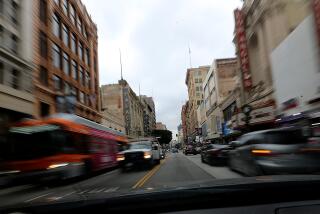L.A. Blamed in Death on Angels Flight
- Share via
The state Public Utilities Commission is blaming poor design, construction and maintenance by the city’s Community Redevelopment Agency and its contractors and inadequate oversight by the commission’s own staff for last year’s fatal crash of the Angels Flight cable railway.
Leon Praport, 83, a survivor of the Holocaust, was killed, and his wife and six other people were injured on Feb. 1, 2001, when one of the Bunker Hill funicular’s two cable cars hurtled down the steep track and collided with its twin.
The terrifying lunchtime accident sent passengers tumbling wildly inside the 100-year-old wooden car and propelled one man out the back door. Crowds of pedestrians at the top and bottom of the hill watched, horrified, and then rushed to aid the victims.
Before the accident, the system, in operation since it was restored in 1996, had a flawless safety record. Since then, it has remained closed.
National Transportation Safety Board investigators have determined that the cable had unraveled from one of the system’s two drums. The PUC report states that there were “critical errors” in the design of the drive system, including the use of gear systems that were “incompatible and subject to failure.”
“This report is not yet final,” said Terrie Prosper, spokeswoman for the commission. “We are still developing material facts from our own investigation and that of the NTSB contractor. We are examining the roles of all involved parties, including our own staff and the designers, builders and operators, and working cooperatively with the NTSB on their investigation.”
The PUC report obtained Monday by The Times is being forwarded to the NTSB for consideration in the final federal report, expected within a few weeks.
The Times learned a year ago that despite their private engineers’ warnings that track brakes were necessary on the cable cars, CRA officials allowed the builders to alter the design to eliminate those brakes and other safety features when the 1901-vintage system was reinstalled in the mid-1990s.
The PUC report, scheduled for release within a few days, states that “although the accident was the direct cause of mechanical failures, staff has concluded the root cause to be one of human error relating to the design, construction, maintenance and regulatory oversight of the Angels Flight railway.”
The commission said that analysis of the circumstances before the accident focused on two areas:
* “Actions of the owner [the CRA] and owner-hired contractors regarding modifications to the original design and the failure to incorporate existing industry standards in the modified design.”
* The commission staff’s shortcomings in “not ensuring that existing safety standards were applied during the design, construction, operation and maintenance” of the 298-foot railway.
As a result of the Angels Flight accident, the PUC in January initiated a proceeding to revamp the way the agency certifies the safety of rail transit carriers such as Angels Flight, and also changed the management of the rail safety division, Prosper said.
The report identified the principal entities involved in the reconstruction as the CRA; the Angels Flight Railway Foundation, a nonprofit fund-raising group; and the Angels Flight Operating Co., a for-profit operating contractor.
The PUC staff recommended that the commission take the “necessary legal steps” to ensure that the railway does not resume operations until the staff certifies the system as safe.
John Welborne, president of the railway foundation, has estimated that it would cost several hundred thousand dollars to build a safer drive system and put Angels Flight back in operation.
Barely a city block in length, the funicular railway has turned up in novels and films. It originally opened on New Year’s Eve in 1901. It was closed in 1969 after passenger traffic had dropped precipitously.
It reopened in 1996 after a $4.1-million restoration and years of struggle by preservationists. In October 2000, the so-called world’s shortest railway was added to the National Register of Historic Places.
The only other fatality to occur on Angels Flight came years earlier, when a World War II sailor died while trying to walk up the tracks as a car was traveling down.
*
Times staff writer Jessica Garrison contributed to this report.
More to Read
Sign up for Essential California
The most important California stories and recommendations in your inbox every morning.
You may occasionally receive promotional content from the Los Angeles Times.










